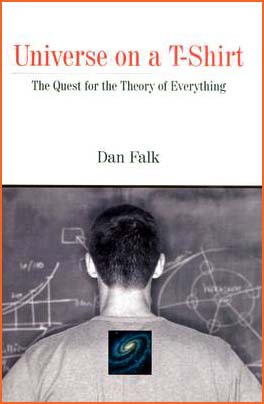
I added the orange border

I added the orange border
| UNIVERSE ON A T-SHIRT The Quest for the Theory of Everything Dan Falk New York: Arcade Publishing, 2002 |
Rating: 5.0 High |
|||
| ISBN-13 978-1-55970-707-7 | ||||
| ISBN 1-55970-707-0 | 246p. | HC/BWI | $24.95 | |
In 585 BC, on the afternoon of the 28th of May,1 shepherds in the Greek province of Ionia were dismayed when a shadow crossed the face of the sun. To the east, the Lydians and Medes were engaged in battle by the river Valys — a battle that capped five years of indecisive conflict. No end was in sight for the armies. But the sudden lapse of sunlight convinced their generals that the gods must be displeased with their pursuit of an interminable war. They met and quickly negotiated a peace treaty. Such was the general belief in those times: any unusual happening was the action of some god or spirit, meant to convey approval or disapproval of current human behavior according to whether it was boon or bane.
Yet even as the sun's light dimmed, another kind of light was breaking. The Greek historian Herodotus tells us that the eklipsis which so startled the Medes and Lydians had been foretold by one Thales of Miletus. This was no vague warning of dire events in the future; Thales had specified the date of occurrence.2 He was able to do this because he viewed such events as arising purely from the interaction of natural objects and forces and, by observing and recording their behavior, had come to recognize patterns and regularities in them. Many modern scholars date the birth of science from this successful prediction of a solar eclipse. Both that conclusion and the details of Herodotus' account are debatable, but what is sure is that this sort of naturalistic world-view was first recorded in ancient Greece, and it has led by fits and starts to the creation of the science-based world we know.
Dan Falk's book, by way of introduction, chronicles the first flowering of Greek scientists and the long detour that followed. The armies of Alexander of Macedon overran the Greek city-states, ending their traditions of philosophical inquiry. Alexander valued practical knowledge but had no interest in pure research; and the same was true of the Roman Empire that followed his. Then came the Christian Church, which preserved the books it inherited but cared little for the knowledge they contained.
"It is not necessary to probe into the nature of things, as was done by those who the Greeks call physici," declared the Christian theologian, Augustine of Hippo (354-430). It is enough for Christians to believe that the only cause of all created things...is the goodness of the Creator, the one true God." – Pages 26-27 |
Falk then leads us, chapter by chapter, through the Scientific Revolution that began during the Renaissance and continues to the present day. It is a familiar story, but the author makes it fresh by clear writing, devoid of equations, by inserting quotations from and about the scientists he profiles, and by presenting anecdotes from their lives and photographs of many of them. Aficionados of physics may wish for a bit more technical detail; but for those new to the abstruse revelations of General Relativity, Quantum Electrodynamics, and Superstring Theory, it is a superb introduction. Each chapter ends with Falk choosing one or two results for his T-shirt. In this way, he highlights the essence of that particular scientific development. There is no bibliography; but he does provide some selected references, and from what I know of those titles, his choices are excellent. End-notes follow this, and finally there is a short but comprehensive index.

 To contact Chris Winter, send email to this address.
To contact Chris Winter, send email to this address.